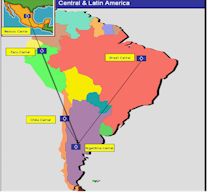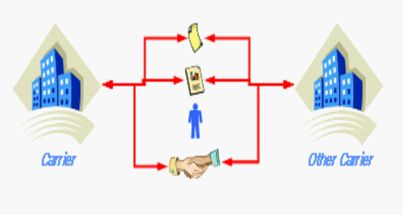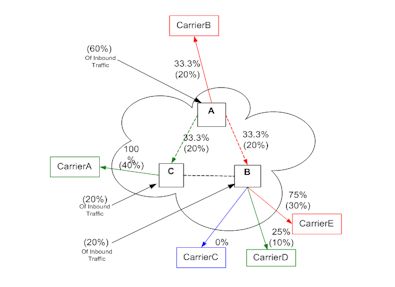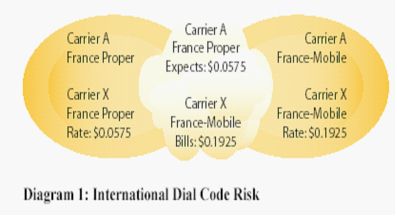|
Global telecommunications carriers create billions
of operational transactions - business events and service records -
every day. Whether it’s fixed or mobile, in-country or across the
world, the telecommunications carriers are, in effect, huge
transaction companies that must sort through every call record,
termination charge, tariff change, and switch record in order to
smoothly and efficiently interconnect the world’s communications. When
interconnect represents 40 to 60 percent of gross margin for a typical
carrier, the failure to quickly and correctly process, analyze, and
respond to ever-changing rates, routes, and regional requirements can
very often be the key difference between profitability and loss for a
carrier.
A More Complex Business Environment An expanding
array of services such as VoIP and mobile services, along with the
exponential increase in the number of service providers have brought
about a new set of challenges for international service providers
including effective agreement management, optimized routing for IP/TDM
networks, and enhanced revenue assurance. In addition, deregulation
and regional consolidation between carriers across a geographical
region has created the need to manage the interconnect business at
local, regional and global level.

This changing telecom
landscape is transforming the interconnect settlement process which
has long relied on agreements with a limited number of other telecom
carriers based on long-term agreements, predictable volumes and simple
per minute pricing. Now, carriers are entering complex business
agreements with multiple partners, each with a different settlement
and rate plan. As a result, carriers are being forced to devote
substantial resources to track and ensure that the financial
obligations of each agreement are satisfied.
The legacy interconnect
and settlement systems which most service providers have relied upon
in the past are struggling to meet today’s dynamic requirements.
These systems typically suffer from lack of functionality, are
cumbersome to change and enhance and most importantly, expensive to
maintain. As a result, the usage and rate information that is
generated by these systems is often not accurate--resulting in
significant vendor invoice reconciliation issues and lost revenue. To
succeed in today’s dynamic business environment, service providers
must deploy a comprehensive interconnect OSS/BSS which provides
effective agreement management, optimized routing for IP/TDM networks,
and the ability to quickly and efficiently bill and audit payments
from multiple partners.
Complex Agreement Tracking and Management
Today,
a typical carrier is interconnected to between 40 and 200 carriers,
each of which is sending multiple rate and dial-code change
notifications each month. Each offer contains details ranging from two
to as many as 1,000 international breakouts. As a result, a carrier
may have to track between 40,000 and 300,000 offer details per month.

The increase in the
number of fixed, mobile and VoIP carriers, as well as the tremendous
volume of daily traffic that is routed on a carrier’s network has
compounded the complexity of managing this process. Typically tracking
traffic, costs and revenue has been done manually using Microsoft
Excel, disparate software solutions or even faxing price documents
back and forth between carriers. The ability to quickly and correctly
process, analyze, and respond to the ever changing rates, routes, and
regional requirements is becoming the key difference between
profitability and loss for a carrier.

Next Generation Optimized
Routing is essential
To address the dynamic
business demands associated with today’s complex interconnect
agreements, carriers will also need the ability to create and
implement global routing strategies in near real time. Yet for many
carriers, commercial routing and technical routing have long been
operated as separate organizations, each with its own business
objectives. This severely limits a carrier’s ability to build global
optimal route guides at the commercial as well as technical level. In
addition, while some of the new softswitches provide better routing
capabilities and some basic LCR support, they are unable to manage the
financial optimization of the network or define quality, margin and
other benchmarks for each switch, service, and destination. As a
result, a carrier’s ability to react quickly to financial risks and
changing network conditions associated with commercial agreements is
severely limited.
The Financial Risks
Associated with Dial Codes
Another challenge in the
current interconnect structure is due to the fact that carriers
receive international termination rates that are based on their
vendors’ destination and dial code number plans. These number plans
are typically different from the carrier’s own number plan and this
discrepancy results in ambiguity around a carrier’s cost of
termination to their interconnect partners.
Traditionally,
interconnected carriers conducted business by exchanging termination
rates to specific countries or geographic locations such as city or
region. The locations are defined by dial-code details. It is this
detail that can provide each carrier with significant risk and
opportunity. A major industry-wide challenge is that there is no
single standard for international numbering plans. Niche international
markets evolve seemingly overnight. This rapid fluctuation makes ITU
dial-codes inherently outdated and non-reflective of how business is
actually transacted. With the rapid expansion of mobile services such
as paging, GPRS and an increased use of number translation services
that are geared to both public and private use, a continuous pattern
of number plans and change band breakouts is developed.
This industry-wide
problem translates into carrier risk because each carrier is defining
their “view” of the world in the form of their dial-codes. A carrier’s
dial-codes drive their cost, routing, pricing, and billing operations.
The carrier risk comes from the differences in how each carrier
defines the dial-codes and the pricing associated with those
differences. As a result, it is common to have a carrier send traffic
to a country assuming it is being terminated and charged as “landline”
traffic when it reality (due to the dial code in use by the other
carrier) the traffic is actually routed and terminated as mobile
traffic, at a significantly higher cost.

For example, assume an
operating carrier (Carrier A) routed 1,000,000 France minutes (50%
proper, 50% mobile) to a vendor (Carrier X) in a month. 50% of the
France Proper minutes (250,000) were treated by Carrier X as
France-Mobile. This results in an unexpected billing of an extra
$0.1350 per minute (the difference between the $0.1925 mobile rate and
the $0.0575 proper rate) for each of these 250,000 minutes. A total
unexpected cost of $33,750.
The Importance of
Interconnect Business Optimization
To address these challenges and capitalize on the reduced costs
associated with IP centric networks, many forward thinking carriers
are deploying Interconnect Business Optimization solutions.
Interconnect business optimization, or IBO, is focused on improving
processes within carrier operations as well as providing the analysis
tools necessary to detect and remedy areas of potential revenue
leakage or cost inefficiency. Interconnect Business Optimization
enables carriers to more optimally leverage their operational
intelligence to manage, route, bill and audit their interconnect
traffic. These innovative solutions are able to define and manage an
infinite number of interconnect agreements with other carriers and
content partners, regardless of the level of complexity. This level
of flexibility enables a carrier to support a variety of agreement
types and rating scenarios including multi-party settlements and
sophisticated revenue sharing partnerships.
By incorporating the
cost and margin associated with each partner agreement, current
network conditions and user defined quality of service benchmarks,
carriers can produce optimal route suggestions at both the commercial
as well as the technical level. Carriers can also automate their
entire global routing process so that optimized network route guides
can activate routing changes directly through both TDM and IP switches,
without any user intervention.
Enhanced Revenue
Assurance
Interconnect
Business Optimization solutions also provide carriers with ability to
detect and eliminate areas of potential revenue leakage. This
capability will become even more essential as carriers interconnect
with multiple carriers and other solution providers, each one
providing a unique product or service which must be tracked and billed.
By leveraging a highly flexible interconnect billing system, a carrier
can eliminate revenue leakage by ensuring that every call is captured,
rated and invoiced correctly, regardless of which type of network the
call originated and terminated on. Combined with a end-to-end audit
and dispute management system, carriers will also be able to
effectively manage the countless interconnect invoices received as
well as streamline the validation process, reconcile charges and
manage settlements between multiple partners.
Succeeding in Today’s Telecom Environment
Over the next few years,
more and more carriers will be migrating away from traditional PSTN to
an IP centric network. The lower costs, increased network
efficiencies and the ability to develop and deploy new revenue
generating services on an IP centric network has made relying on
traditional TDM technologies a losing proposition for most carriers.
Yet, the promise of reduced costs and greater operational efficiencies
associated with these new networks will not be realized unless
carriers also optimize their entire interconnect business. Only by
deploying interconnect business optimization solutions that can manage
complex business agreements, optimize the routing of traffic, reduce
dial code risk and eliminate revenue leakage will carriers be able to
enjoy the benefits that IP centric networks provide.
Telarix, Inc.
8065
Leesburg Pike
Suite 600
Vienna, VA 22182
www.telarix.com
Lisa Perez
Regional Sales Manager (Americas)
[email protected]
+ 1 (703) 564 9626
Thomas D. Do
Solutions Consultant
[email protected]
+ 1 (312) 265 8330
Steve Chase
VP of Marketing
[email protected]
+ 1 (703) 564 9747
|

